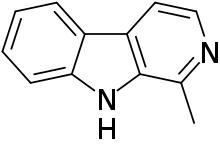Harmane
 | |
| Names | |
|---|---|
| IUPAC name
1-Methyl-9H-pyrido[3,4-b]indole | |
| Other names
Harman, Aribine, Aribin, Locuturine, Locuturin, Loturine, Passiflorin, 1-Methylnorharman, NSC 54439 | |
| Identifiers | |
3D model (JSmol) |
|
| ChEBI | |
| ChemSpider | |
| EC Number | 207-642-2 |
| KEGG | |
PubChem CID |
|
| |
| |
| Properties | |
| C12H10N2 | |
| Molar mass | 182.23 g·mol−1 |
| Melting point | 235–238 °C (455–460 °F; 508–511 K) |
| Soluble to 10 mM in 1 eq. HCl[1]
methanol: soluble 50 mg/ml | |
Except where otherwise noted, data are given for materials in their standard state (at 25 °C [77 °F], 100 kPa). | |
| Infobox references | |
Harmane (harman) is a heterocyclic amine found in a variety of foods including coffee,[2] sauces,[3] and cooked meat.[4] It is also present in tobacco smoke.[5]
Chemistry
Harmane is a methylated derivative of β-carboline with the molecular formula C12H10N2.
Biological effects
Harmane is a neurotoxin[4][6] that is strongly associated with essential tremor, one of the most common neurological diseases in the elderly.[7]
Additionally, harmane is a monoamine oxidase inhibitor[2][8][9] and believed to be the main endogenous ligand for the benzodiazepine receptor.[10]
See also
References
- ↑ "Harmane". tocris.com.
- 1 2 Herraiz, T; Chaparro, C (2006). "Human monoamine oxidase enzyme inhibition by coffee and beta-carbolines norharman and harman isolated from coffee". Life Sciences. 78 (8): 795–802. doi:10.1016/j.lfs.2005.05.074. PMID 16139309.
- ↑ Herraiz, T. (2004). "Relative exposure toβ-carbolines norharman and harman from foods and tobacco smoke". Food Additives and Contaminants. 21 (11): 1041–50. doi:10.1080/02652030400019844. PMID 15764332.
- 1 2 Louis, E. D.; Zheng, W; Jiang, W; Bogen, K. T.; Keating, G. A. (2007). "Quantification of the neurotoxic beta-carboline harmane in barbecued/grilled meat samples and correlation with level of doneness". Journal of Toxicology and Environmental Health, Part A. 70 (12): 1014–9. doi:10.1080/15287390601172015. PMC 4993204. PMID 17497412.
- ↑ Herraiz, Tomas; Chaparro, Carolina (2005). "Human monoamine oxidase is inhibited by tobacco smoke: β-carboline alkaloids act as potent and reversible inhibitors". Biochemical and Biophysical Research Communications. 326 (2): 378. doi:10.1016/j.bbrc.2004.11.033. PMID 15582589.
- ↑ Celikyurt, I. K.; Utkan, T; Gocmez, S. S.; Hudson, A; Aricioglu, F (2013). "Effect of harmane, an endogenous β-carboline, on learning and memory in rats". Pharmacology Biochemistry and Behavior. 103 (3): 666–71. doi:10.1016/j.pbb.2012.10.011. PMID 23107644.
- ↑ Louis, E. D.; Zheng, W; Jurewicz, E. C.; Watner, D; Chen, J; Factor–Litvak, P; Parides, M (2002). "Elevation of blood β-carboline alkaloids in essential tremor". Neurology. 59 (12): 1940–1944. doi:10.1212/01.wnl.0000038385.60538.19. PMC 4992345. PMID 12499487.
- ↑ Rommelspacher, H; May, T; Salewski, B (1994). "Harman (1-methyl-beta-carboline) is a natural inhibitor of monoamine oxidase type a in rats". European Journal of Pharmacology. 252 (1): 51–9. doi:10.1016/0014-2999(94)90574-6. PMID 8149995.
- ↑ Adell, A; Biggs, T. A.; Myers, R. D. (1996). "Action of harman (1-methyl-beta-carboline) on the brain: Body temperature and in vivo efflux of 5-HT from hippocampus of the rat". Neuropharmacology. 35 (8): 1101–7. doi:10.1016/s0028-3908(96)00043-3. PMID 9121613.
- ↑ Rommelspacher, H; Nanz, C; Borbe, H. O.; Fehske, K. J.; Müller, W. E.; Wollert, U (1980). "1-Methyl-beta-carboline (harmane), a potent endogenous inhibitor of benzodiazepine receptor binding". Naunyn-Schmiedeberg's Archives of Pharmacology. 314 (1): 97–100. doi:10.1007/bf00498436. PMID 6255348.
This article is issued from
Wikipedia.
The text is licensed under Creative Commons - Attribution - Sharealike.
Additional terms may apply for the media files.